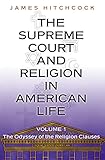The Supreme Court and Religion in American Life, Vol. 1 : The Odyssey of the Religion Clauses / James Hitchcock.
Material type: TextSeries: New Forum Books ; 43Publisher: Princeton, NJ : Princeton University Press, [2009]Copyright date: ©2004Edition: Course BookDescription: 1 online resource (232 p.)Content type:
TextSeries: New Forum Books ; 43Publisher: Princeton, NJ : Princeton University Press, [2009]Copyright date: ©2004Edition: Course BookDescription: 1 online resource (232 p.)Content type: - 9780691116969
- 9781400826254
- 801.95
- PN94
- online - DeGruyter
- Issued also in print.
| Item type | Current library | Call number | URL | Status | Notes | Barcode | |
|---|---|---|---|---|---|---|---|
 eBook
eBook
|
Biblioteca "Angelicum" Pont. Univ. S.Tommaso d'Aquino Nuvola online | online - DeGruyter (Browse shelf(Opens below)) | Online access | Not for loan (Accesso limitato) | Accesso per gli utenti autorizzati / Access for authorized users | (dgr)9781400826254 |
Frontmatter -- CONTENTS -- Introduction to Volume 1 -- CHAPTER ONE. The Kingdom of This World -- CHAPTER TWO. Belief and Action -- CHAPTER THREE. The Phantom Wall -- CHAPTER FOUR. Clouds of Witnesses -- CHAPTER FIVE. Expansion -- CHAPTER SIX. Contraction -- CHAPTER SEVEN. Religious Education and Public Support -- Conclusion -- Notes -- Bibliography -- Index of Justices -- Index of Cases -- General Index
restricted access online access with authorization star
http://purl.org/coar/access_right/c_16ec
School vouchers. The Pledge of Allegiance. The ban on government grants for theology students. The abundance of church and state issues brought before the Supreme Court in recent years underscores an incontrovertible truth in the American legal system: the relationship between the state and religion in this country is still fluid and changing. This, the first of two volumes by historian and legal scholar James Hitchcock, provides the first comprehensive exploration of the Supreme Court's approach to religion, offering a close look at every case, including some that scholars have ignored. Hitchcock traces the history of the way the Court has rendered important decisions involving religious liberty. Prior to World War II it issued relatively few decisions interpreting the Religious Clauses of the Constitution. Nonetheless, it addressed some very important ideas, including the 1819 Dartmouth College case, which protected private religious education from state control, and the Mormon polygamy cases, which established the principle that religious liberty was restricted by the perceived good of society. It was not until the 1940s that a revolutionary change occurred in the way the Supreme Court viewed religion. During that era, the Court steadily expanded the scope of religious liberty to include many things that were probably not intended by the framers of the Constitution, and it narrowed the permissible scope of religion in public life, barring most kinds of public aid to religious schools and forbidding almost all forms of religious expression in the public schools. This book, along with its companion volume, From "Higher Law" to "Sectarian Scruples," offers a fresh analysis of the Court's most important decisions in constitutional doctrine. Sweeping in range, it paints a detailed picture of the changing relationship between religion and the state in American history.
Issued also in print.
Mode of access: Internet via World Wide Web.
In English.
Description based on online resource; title from PDF title page (publisher's Web site, viewed 30. Aug 2021)


